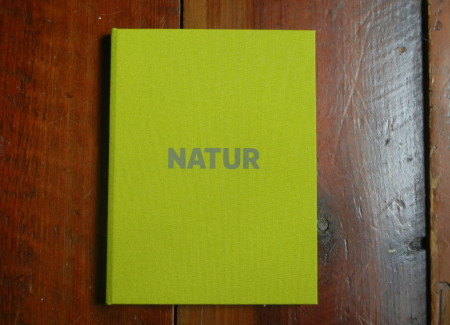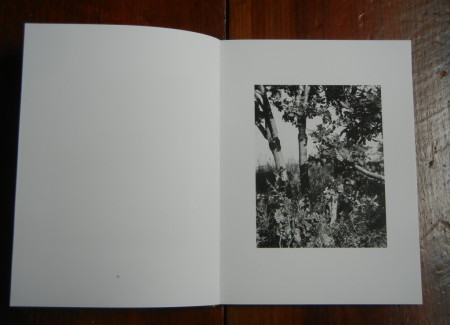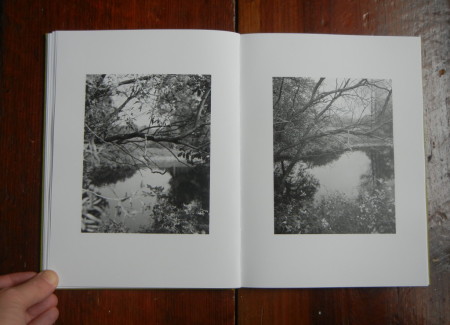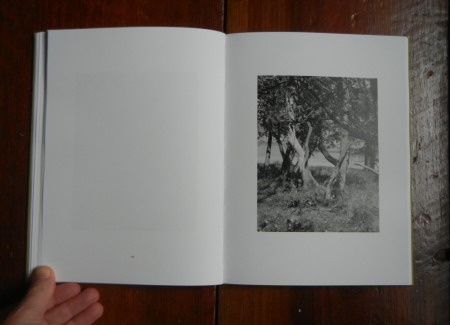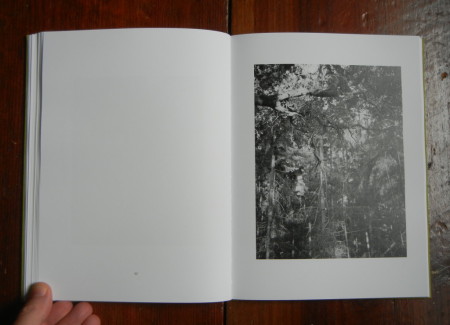JTF (just the facts): Published in 2014 by MACK Books (here). Hardcover, 104 pages, with 63 black and white images. The photographs were taken between 1987 and 1997, with most made in the late 1980s. There are no essays or texts. (Spread shots below.)
Comments/Context: Michael Schmidt’s newest book, Natur, delivers something few in this world of contemporary photography would have thought possible – using straight black and white landscape photography, he’s done something new. If you idly flip through this book at your local bookstore, you will almost certainly miss it. You’ll likely see flashes of aesthetic commonality with Robert Adams, or Albert Renger-Patzsch, or Lee Friedlander, which will seem altogether familiar, and you’ll assume that you’ve seen this quiet narrative before; you’ll close the book, believing you understand its contents before really looking. And you’ll be wrong.
Schmidt’s innovations start with the same visual intelligence he applied to anonymous urban spaces around Germany, only now aimed at anonymous natural spaces – empty paths through ordinary local forests, forgettable streams and ponds, in-between zones of whispering grass and dappled light, thickets of underbrush and fallen branches, a bird, a cow, a copse of trees in the middle distance. There is the sense that this land isn’t at all special, and yet it holds our interest, just like the apartment blocks, small towns, and local residents did in his previous bodies of work. A tree with unexpected majesty, a view down a road flanked by evergreens, the curve of a twig that catches our eye, they all come quietly forth to be noticed, and to tell us their modest stories.
The book itself is like a slow, meditative walk through the woods, or a Hamish Fulton hike through neighboring hills and valleys. It’s as if the photographs track the path of an ambler’s eyes, from the jagged oak leaves, to the hollow in the tree trunk, to the worn area at the edge of the stream, to the light that catches on the breezy leaves high above. Schmidt continually plays with depth of field and focus, allowing branches to poke out into our eyes, and then stepping back or just to the side to replay the scene from a slightly different vantage point, forcing us to slow down and notice the changes and repetitions. Sticks and twigs push at us or veil and interrupt our view, until we refocus on the background. The light then shifts and mottled greys get incrementally darker, a silver becoming more delicate or prominent. The landscapes aren’t balanced in a pleasingly conventional way, they have just a hint of dissonance that makes them momentarily puzzling.
What Schmidt has done here is create a linear narrative through the woods, each picture a step along the way, a detail observed, a vista enjoyed, or a shadowed enclosure offering its coolness. Like few landscape photobooks I can recall, it has a definite forward cadence, an easy going momentum that uses the page flips to turn our attention, to pull us in for a closer look at something near the path, or to allow us some breathing room to step through the clearing. The unimpressiveness of the terrain, the broken branches and ungainly trunks, the sandy wastes and the too tall weeds, they’re all given surprisingly full attention by Schmidt, making us look harder to see something in the nothing. In the end, we seem to return, refreshed by the heightened awareness of our humble excursion into nature, the stubble of farmland in the distance.
While the honesty of these photographs is authentic, I came away most impressed by Schmidt’s masterful control of the visual experience. With an almost invisible touch, he twisted my head fore and back, made me look up and down, highlighted overlooked details, widened my scope, and pulled me through underbrush I would normally have avoided. The movement of the images creates a nearly imperceptible rhythmic flow, a sense of leisurely, but slightly uneasy journey. The photobook is proof that there is something nourishing to be found in even the most dull and unassuming natural surroundings, especially when led by someone as thoughtful as Schmidt.
Collector’s POV: Michael Schmidt is represented by Galerie Nordenhake in Berlin/Stockholm (here). Schmidt’s work has surprisingly little secondary market history, with only a handful of lots changing hands in the past few years; the prints that have found buyers have generally sold for under $4000.
